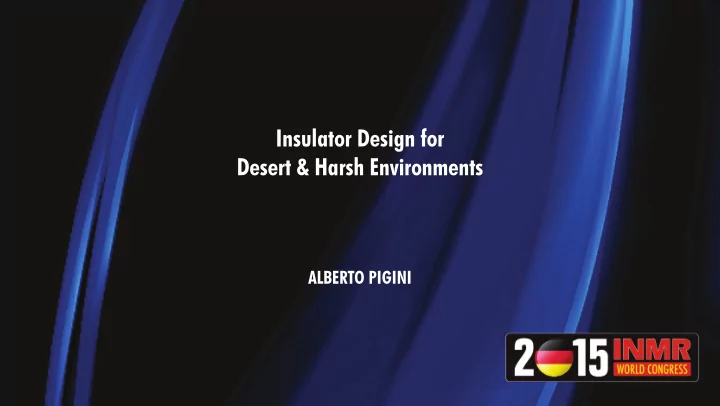

Insulator Design for Desert & Harsh Environments ALBERTO PIGINI
INSULATOR DESIGN FOR DESERT AND HARSH ENVIRONMENT ALBERTO PIGINI
CONTENT OF THE PRESENTATION • INTRODUCTION • FIELD EXPERIENCE • ASSESSMENT OF POLLUTION SEVERITY • INSULATOR PERFORMANCE IN HARSH CONDITIONS • DESIGN FOR HARSH ENVIRONMENT • CONCLUSIONS
INTRODUCTION • In harsh environment under AC and especially under DC pollution may dominate the design • Accurate design is necessary to limit costly under and over design. • Accurate design is especially important for composites
FIELD EXPERIENCE «Standard» 53,7 mm/kV is not sufficient. Examples: • Saudi Arabia: better performance in AC with 86 mm/kV. Still some flashovers and need of washing • Need of systematic line washing also reported from Iran Jordan , Algeria, Tunisia, Egypt, Emirates, Israel, Morocco, Peru and Mexico • Still controversy on the possibility to partially solve theproblem with polymeric insulators • Field experience confirm the need of an accurate design. For an accurate design the site severity condition and the insulator performance are to carefully defined. A statistical design approach may help.
ASSESSMENT OF POLLUTION SEVERITY Contamination degree very different in different areas depending on: • Location (eg. Distance form the sea) • Type of sand • Additiona Industrial pollution
ASSESSMENT OF POLLUTION SEVERITY
ASSESSMENT OF POLLUTION SEVERITY
ASSESSMENT OF POLLUTION SEVERITY Need of pollution maps: • To take into account both ESDD and NSDD (type of chemical) • Calibration by long duration campaigns by suitable stations. • Specific measurements in areas of specific interest • For DC necessity of measurements on energized insulators
ASSESSMENT OF POLLUTION SEVERITY Need of estimate of number of pollution events (as an example the range for Saudi Arabia between brackets) : • Fog days (0-64) • Rain days (5-31) • Very high humidity days (40-88)
INSULATOR PERFORMANCE IN HARSH CONDITIONS • Insulator types carefully selected (aereofoil, antifog, coated insulators, composite insulators). • perform tests on the insulator selected simulating the expected contamination condition (non standard contamination). • For preliminary design reference to available experimental data can be made.
INSULATOR PERFORMANCE IN HARSH CONDITIONS For preliminary design formulas are defined to take into account: • RUSCD for AC/DC solid layer and salt fog
INSULATOR PERFORMANCE IN HARSH CONDITIONS For preliminary design formulas are defined to take into account: • RUSCD for AC/DC solid layer and salt fog • Correction for insulator geometry • Correction for wettability conditions • SDD estimate starting from ESDD and NSDD
DESIGN FOR HARSH ENVIRONMENT • AC cap and pin insulators. 10 pollution events, 100 insulators contaminated. ESDD=1 mg/cm2, NSDD 0,1-1 and 10 mg/cm2
DESIGN FOR HARSH ENVIRONMENT • AC cap and pin insulators. 100 insulators contaminated. ESDD=1 mg/cm2, NSDD=10 mg/cm2, Number of pollution events: 1-10 and 100.
DESIGN FOR HARSH ENVIRONMENT • AC cap and pin insulators. 100 insulators contaminated. ESDD=1 mg/cm2, NSDD=10 mg/cm2, 10 pollution events. Influence of hydrorepellency (black curve uncoated insulator with W=7), red curve coated but aged (W=6), violet curve coated with W=4.
CONCLUSIONS • Service experience confirms that IEC general indications are not adequate for desert-desert coastal environment • Pollution severity can reach extreme values in the examined region, varying however site by site. Also the number of pollution events are very variable. Consequently an accurate pollution mapping is necessary for an optimized design. • The insulator type should be specifically selected and possibly tests should be carried out to assess the performance of the insulators simulating the application conditions. • Preliminary evaluation can be carried out by extrapolating available knowledge • For an accurate design a statistical approach is to be used as shown by a few examples in the paper.
Recommend
More recommend